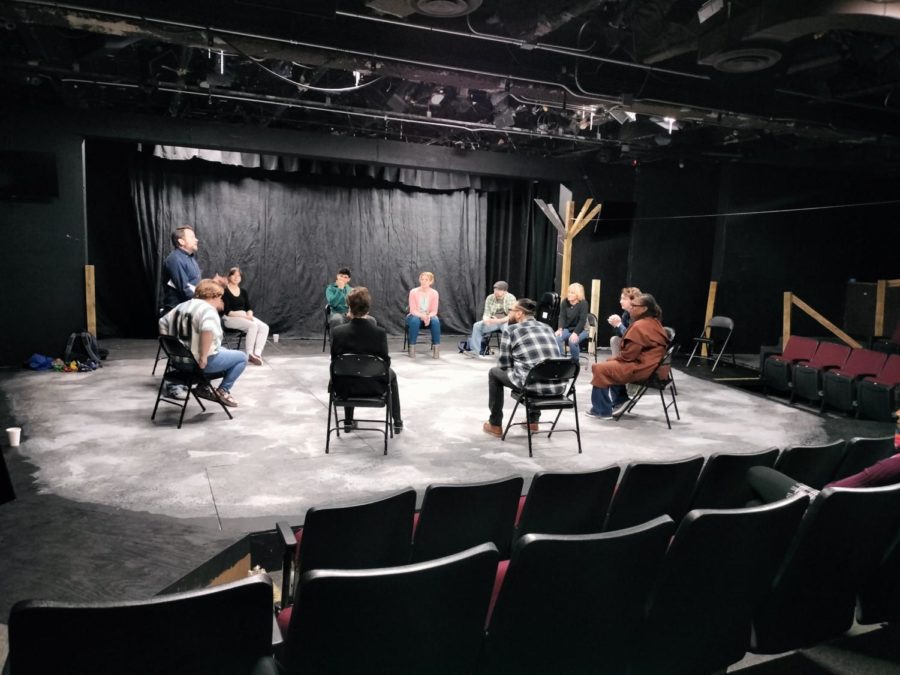Café Improv: A Night of Laughter, Bonding and Spontaneity at Stage Center Theater
April 21, 2023
On Thursday, March 30, 2023, the NEIU Theatrics Coordinator, Jeremy Babcock, hosted Café Improv in the Stage Center Theater. The audience was invited to participate on stage to do improvisational activities. The art of improv is all about being in the moment and taking advantage of any and all serendipitous opportunities.
According to Babcock, “[improv] is what you know and what I know, and it is a true discovery between the two of us. That is really what it is about.” Café Improv aimed to create an interactive experience that not only entertained but also strengthened the bond between students, staff and faculty members. The improv activities focused on collaboration, cooperation, trust, communication but most importantly, awareness of one’s surroundings. Each participant must be fully aware of all other team members in order to give a clever and adequate response to their actions.
The various activities inspired participants to step out of their comfort zones and work towards a common goal. Speaking of which, Jordi Banuelos, undergraduate student in computer science, stated that he was “really nervous because the majority of the people there were all staff”. However, improvisation allows participants to escape their comfort zones. Jatziry Ramos Jacobo, undergraduate student in fine arts, affirmed that improv is “a moment for you to really be free” and her sentiment was that in class, students normally have to just go with what others are saying, “but with improv, you are able to do whatever you want, so just really be yourself.” Other comments among the participants included claims that it felt like a theater class, drama lesson, a trust exercise or a team-building activity.
One particular activity featured all but one participant forming a circle, and that one participant would be in the center of the circle. The centered participant must find things that he or she enjoys that others are likely to enjoy. If somebody on the circle’s bounds finds the thing enjoyable too, then that person must cross through the circle to find a new opening somewhere else in the circle. Finding commonplace with the participants on the border of the circle allows the centered person to steal that spot on the border. Furthermore, the opportunity to learn about other people’s likes and dislikes allows everybody in the circle to get to know each other more. Another variation of the same activity features two people in the center, and they must find common ground on something they enjoy in order to find at least one new opening on the bounds of the circle.
Another activity allowed the participants to make eye contact with their neighbors on the bounds of the circle and elicit saying a common agreed-upon food item, such as tacos, pizza, or ice cream, which elicits turning to the adjacent neighbor and saying a different agreed-upon food item. This was done in a clockwise fashion in the circle. An agreed upon color would also be thrown into the mix between neighbors, and the pattern would continue. The two patterns would continue moving in a clockwise direction, and each participant must focus on each of their neighbors’ two food items and colors that are in the mix. A third pattern can also be thrown in, like a favorite location or travel destination, to make the activity more challenging. Advanced groups can continue to add patterns until they reach a desired level of difficulty.
A third activity that took place included creating a script between a participant’s two index fingers that are characters in a scene. The scene is based on a location. The narrator is the owner of the two fingers, and he or she must say “where has my finger been, said where has my finger been? say what? where has my finger been, said where has my finger been?” A location is thrown out and the name of somebody else in the circle is stated. The corresponding person must make a dialogue between their index fingered characters at that new location. After the script is complete between the two characters, “where has my finger been?” is played out again by that new narrator and thrown to a newer participant. The newer narrator would make up a scene about that location and eventually ask “where has my finger been” and select a new location and new narrator. A few of the locations chosen in this particular group of participants were Salt Lake City, an insane asylum and ancient Rome. Banuelos stated that his “favorite improv [exercise] was the one with the fingers.” When The Independent interviewed Banuelos’ girlfriend, Jacobo, separately, she also admitted that her favorite improv exercise was “the fingers one.” Together, the happy couple agreed that they both liked the silliness that came out of each participant’s responses. They both thought that my portrayal of the insane asylum was funny when I talked about the “straightjacket [and] give me my meds” during the finger activity.
Eye contact and the awareness of a teammate’s actions are crucial during improv because Babcock said “[improv] is about this group, it is not just [the individual’s] idea.” Thus, improv theater is about having a team-oriented mindset and group dynamic. Improv theater offers both a novel approach as an icebreaker and a source of entertainment for any group of people. Babcock has commented that people usually feel much more comfortable with the group after the first couple of exercises, at which point he would break out into practicing and rehearsing a theatrical scene from a play during an academic class of theatrics.
The importance of taking a dive into unknown and novel activities has its benefits to all students because as Banuelos put it, “the more you do things like [improv], it gets you ready for interviews.” Banuelos also admitted that when working in a real job, employers may ask you unexpected questions and put you on the spot, so it is beneficial for everyone to practice being in that situation. Jacobo recommends other students to take part in improvisation exercises because it helps to “take some stress off from school and any other personal problems.” Thus, improvisation has real-world application to all students, regardless of the career that students choose!









